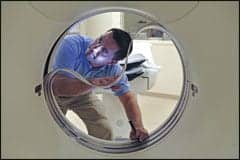As the healthcare industry continues to evolve, it is important for HTM to balance advancements with sustainability.
By Agapito E. Morgan
Because the healthcare industry is ever-evolving, providers must make near-constant investments in equipment, technology, and other resources to provide the highest level of patient care and remain competitive while also being mindful of the impact on our environment through sustainability.
The healthcare sector is a major contributor to the causes of climate change. In the U.S., healthcare accounts for nearly 20% of gross domestic product (GDP), making it a major consumer of resources, and major producer of waste and greenhouse gases – 8.5% of all U.S. carbon emissions stem from the healthcare sector.
Thankfully, medical advancements keep coming, and the industry needs to balance these advancements with maintaining our natural resources. Here are three eco-friendly actions healthcare technology professionals can take—and everything starts with a plan.
1. Create a sustainability strategy.
For a sustainability plan, practicality is key. A realistic plan for implementation is as important as the strategy itself. Begin with defining the organization’s sustainability objective. Then, identify any potential issues and determine the human and equipment resources needed for success. Which decision-makers and workers will most likely get the job done—and how will they do it? Who will manage the project? How will the work be accomplished? How will you measure and communicate the results?
Engagement is another important element of a sustainability strategy. Is a top-down approach or a grassroots campaign best for your organization? Or maybe a committed task force?
Taking ownership of the negative environmental impacts related to providing quality healthcare presents a complicated, costly dilemma for the sector. Furthermore, an effective carbon reduction plan requires significant capital and human resources. While investing in sustainability has proven, positive results, how do you pay for it, and where do you begin?
2. Embrace telehealth to reduce transportation emissions.
Transportation is one of the biggest opportunities for hospitals and healthcare organizations to reduce greenhouse gas numbers. According to this study, the transportation sector is the largest source of greenhouse gas emissions in the U.S., with transportation activities accounting for 29% of the total U.S. emissions in 2021, according to the Environmental Protection Agency.
Consider the sheer number of patients traveling to and from medical appointments daily. Healthcare organizations can make huge strides in their sustainability goals with a few transportation upgrades.
The more obvious options for improvement are replacing gas-powered fleet vehicles with electronic vehicles (EVs), installing onsite charging stations for staff and patrons, and offering commuting incentives that promote carpooling or public transportation use.
Creating and/or expanding telehealth programs is another option for healthcare providers to mitigate their carbon footprint. Large providers, such as UC Davis Health, embrace technology and the benefits of virtual care. Research teams from UC Davis conducted a study to assess the reduced carbon footprint offered by telehealth visits during the pandemic compared to in-person visits.
According to UC Davis, “The study found substantial savings for patients and the environment, including eliminating the need to commute 53,664,391 miles – that’s 113 round trips from Earth to the moon. Telehealth also saved an estimated 204 years of travel time, $33,540,244 travel-related costs, 42.4 injuries and 0.7 fatalities.”
According to this Wall Street Journal article, CommonSpirit Health saved 7,662 metric tons of carbon dioxide in 2022 through telehealth and Kaiser Permanente’s Northwest region recently reduced its carbon footprint by about 7,500 metric tons a year.
3. Leverage integrated robotics technology.
Artificial Intelligence (AI) technology is growing rapidly within the industry. The global AI in healthcare market size was estimated at $22.45 billion (USD) in 2023 and is expected to expand at a compound annual growth rate (CAGR) of 36.4% from 2024 to 2030. This factor creates an opportunity for healthcare organizations to leverage machines, drastically shifting operating modes while still prioritizing patient care.
AI can help providers gather, store, and analyze information, creating large datasets to glean information. AI can also optimize machine performance, reducing energy use and medical waste.
AI technology in the form of software and hardware can transform the healthcare industry and make it more efficient and sustainable. More than 200,000 industrial robots are installed annually around the world. In healthcare, they are used to perform integral work in operating rooms, as well as deliver supplies throughout a hospital facility. Robotic process automation (RPA) comprises computer programs utilized for efficiency and accuracy in repetitive tasks, like prior authorization, patient billing, and similar work.
Selecting a Financing Team
Modern healthcare technology is a large investment, so many providers choose to finance it– allowing them to reap the benefits of state-of-the-art technology with minimal impact on capital budgets. When financing healthcare technology solutions, healthcare companies should consider return on investment (ROI), the financing structure and the lending team’s capabilities.
Here are the qualifications to look for when choosing a financing provider:
- A clear understanding of your business and the overall healthcare technology arena
- A proven track record in customizing sustainable, scalable financing structures to support your goals
- A trusted, reliable source of capital
- Experience in creating strategic plans to reduce your organization’s energy consumption
- A well-established team that has survived economic ups and downs and is experienced in financing healthcare equipment
Agapito “Aga” Morgan is a commercial healthcare leader at KeyBank. Questions and comments can be directed to [email protected].





